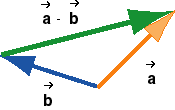

A Very Useful Remark About The Comparison Method
The construction of the difference  -
-  by the
comparison method relates directly to the physical
interpretation of the difference as a change. The points
at the tips of the two vectors
by the
comparison method relates directly to the physical
interpretation of the difference as a change. The points
at the tips of the two vectors  and
and  can be interpreted as
positions of a particle at two different times, the point at the
tip of
can be interpreted as
positions of a particle at two different times, the point at the
tip of  being the position at an
earlier time and that at the tip of
being the position at an
earlier time and that at the tip of  at a later time.
at a later time.
The two vectors  and
and  can then be interpreted as the
position vectors of the particle at the two times, relative to a
fixed origin at the point where the two tail ends join. Then
can then be interpreted as the
position vectors of the particle at the two times, relative to a
fixed origin at the point where the two tail ends join. Then
 -
- , the later minus the earlier position vector,
represents the change in the particle's position vector
during the given time interval, and this change points in the
direction in which the particle's position is changing, which is
from
, the later minus the earlier position vector,
represents the change in the particle's position vector
during the given time interval, and this change points in the
direction in which the particle's position is changing, which is
from  to
to  . (Note that the change in a quantity is always
the later value minus the earlier value. E.g., if a number
changes from 4 to 10, it changes by 6, and this change is equal
to 10 - 4, the later minus the earlier value.)
. (Note that the change in a quantity is always
the later value minus the earlier value. E.g., if a number
changes from 4 to 10, it changes by 6, and this change is equal
to 10 - 4, the later minus the earlier value.)
More generally, when you have to construct the difference
 -
-  of two vectors, think of the first vector,
of two vectors, think of the first vector,  , as the later value of some vector
quantity and the second one,
, as the later value of some vector
quantity and the second one,  ,
as the earlier value, think of
,
as the earlier value, think of  -
-  as the change in the
quantity, and then draw
as the change in the
quantity, and then draw  and
and
 tail-to-tail. The change in
the quantity, i.e.,
tail-to-tail. The change in
the quantity, i.e.,  -
-  , will point from the tip of the
earlier value
, will point from the tip of the
earlier value  of the quantity
to the later value
of the quantity
to the later value  .
.
The add-the-negative method allows no such interpretation
because the green difference vector in that construction does
not point from the earlier to the later value of any quantity.
It points from the tail end of vector  to the tip of vector -
to the tip of vector - , and these points do not have a physical
interpretation.
, and these points do not have a physical
interpretation.